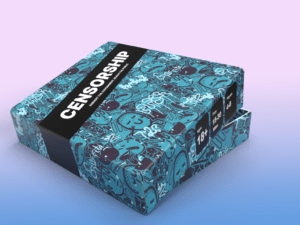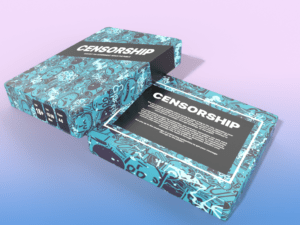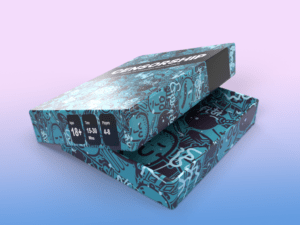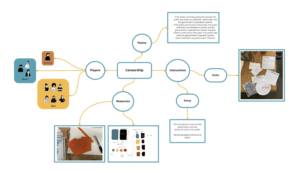Introduction
A group of graffiti artists is attempting to build a name for themselves in the city by disseminating a subversive message to the general public. However, they face opposition from the government, which views their art as vandalism. The artists’ objective is to communicate their message to the public through drawings. To avoid being arrested by authorities, artists work at night, staying quiet and working in shifts, with one artist sketching at a time and others keeping an eye out for police, in order to collaboratively produce the largest and most unique piece possible. The government then censors the piece at sunrise, leaving it to the public to assess if the message was received. Are you up to the challenge? Play Censorship to find out.



Our game, Censorship, has a few objectives. Our primary objective was to build a game that fosters creativity and collaboration. For those reasons, the collaborative element of our game served as the primary hook and function of our game. Our secondary objective was to add a gentle learning curve into the game by giving players an opportunity to enhance their sketching skills. Finally, we wanted our game to allow individuals to unleash their artistic talents and imagination during the game.
We can view a concept map of our game below that models game mechanics and how players will interact with the game.

Our game lies in the realm of fellowship and creativity and is a player v. player game with a team of artists united with a single member of the public against the government. The objective of the game is to outwit the government and create art that reaches the public.
The rules and procedures are as follows.
Setup:
- Pick one person to serve as the government, and one person to serve as the public.
- Remaining players will serve as artists.
Rules:
- Play (1 minute) — Artists
- Artists should draw one single prompt card from the deck. Every artist should silently look at the single prompt card. The public and government are not allowed to see the prompt.
- The public should start a timer for 45 seconds.
- Artists will take turns contributing to a collaborative drawing in response to the prompt. Each artist is allowed to add one stroke, and when the pen is lifted, they must pass the canvas to the next artist.
- A stroke is defined as a continuous line where the drawing tool does not leave the paper.
- Strokes that have been made are not allowed to be erased.
- Artists cannot do the following:
- Speak to each other during drawing time.
- Include any type of text within their drawings.
- React when the public is guessing.
- Make multiple copies of the same idea (e.g. you cannot fill up the canvas with multiple tiny birds if your prompt is “bird”).
- The public should stop the timer at 45 seconds and artists should stop drawing.
- Censoring (15 seconds) — Government
- The public should start a timer for 15 seconds.
- The government has 15 seconds to censor the graffiti using one censor of their choice (or none at all).
- The public should stop the timer at 45 seconds and the government should stop whatever they are doing.
- Judging (20 seconds) — Public
- The public has 20 seconds to guess the subject of the drawing.
Points:
- If the public correctly guesses the prompt, the public and artists are awarded 1 point each, and the government is awarded no points.
- If the public cannot guess the prompt, the public and artists are awarded no points, and the government is awarded the number of points shown on the censor they used. If no censor was used, the government is awarded 5 points.
- Game ends when any person wins 10 points.
Resources:
- 1 deck of prompt cards sorted and colored by category
- 3 censors
- 1 instruction sheet
- 1 whiteboard
- 1 whiteboard marker
The game values explicit art that subverts the government and our game leans into the theme of censorship with prompts that features body parts, political figures, and political events — the decision to blur the boundary between reality and simulation creates greater player buy-in, discussion, and laughter when playing the game.
Testing and iteration history
Our game went through a number of iterations, as we experimented with in-game points, drawing boards, timing, and game theme and prompts. We found that timing is an essential component of party games involving creativity and that game themes are essential for generating audience buy-in, as we leaned into the idea of censorship as a game and created more explicit and politically-charged prompts.
Playtest 1
Facilitators: Jen, Peng
Notetakers: Malika
Testers: 4
Changes: Players were assigned to be either 1) artists, 2) the government, or 3) the public. Players were then given three minutes to take turns collaboratively drawing a shared prompt on a sheet of paper divided into fourths. The government was then given the opportunity to remove one section of the drawing. Finally, the public was given the opportunity to guess the prompt from looking at the collaborative drawing.
Summary: We ran our first playtest in section. Things that went well: players enjoyed the creativity involved in creating a collaborative drawing, collaborative drawing proved to be an intellectually stimulating and discussion-provoking exercise, players liked the timed component to drawing, and players really bought into the theme of the game. Things that didn’t go well: three minutes was far too long for drawing time, the public quickly grew bored while waiting for players to finish drawing, and physically dividing up the drawing into fourths posed a host of issues — taking out a piece either made a disproportionate difference when players had too small of a drawing or made no difference at all when players drew to fill the page. Additionally, dividing up the drawing in fourths limited our number of players to a constant four, and any additional or fewer players would require dramatically refiguring the page into equal pieces.
Playtest 2
Facilitators: Peng
Notetakers: Jen
Testers: 5
Changes: We kept the same rules, condensed time limits for drawing down to 45 seconds, and modified the drawing board. This time, instead of having players draw on a page divided into equal sections and the government remove a section of the drawing, we had players draw on a single sheet of paper and the government censor a section of the drawing with a sticky note, which we call a “censor.” Additionally, we experimented with different sizes and styles for censors, as well as different categories for prompts, this time including prompts featuring animals and people.
Summary: We ran our second playtest at game night. Things that went well: having various sizes for censors allowed us to establish a point system which became the objective of our game, including people in the prompt categories cultivated more dialogue, discussion, and laughter amongst players, and players commented that utilizing sticky notes as censors aligned well with the theme of the game and suggested we lean more into the theme of the game. Things that didn’t go well: the time limit felt too short for the complexity involved in drawing people, the public was either bored when we did not assign them a task, or overwhelmed when we assigned them the task of writing their own censors and prompts, and the points system was confusing.
Playtest 3
Facilitators: Jen
Notetakers: Janice, Malika
Testers: 5
Changes: Keeping the same rules, this time we raised time limits for drawing to 1 minute, incorporated more explicit prompts to fit with the theme of censorship, featuring prompts on the topic of body parts, nudity, political figures, and political events. Additionally, we reconfigured the points system to utilize physical tokens to track points, to reduce the burden on the user to track their own points. We also added clarifying labels to the censors, limiting censors to only three different sizes, to further reduce the burden on the government when censoring the drawing. Finally, we kept the public in charge of the timer, to give the public an active task rather than simply sit alone as players drew.
Summary: We ran our third playtest in class. Things that went well: players loved the explicit prompts and truly bought into the theme of the game and more dialogue, discussion, and laughter was created amongst players, the government had no issues figuring out what the censors represented since everything was clearly labeled, the public felt immersed and and preoccupied with the game while tracking times for the government and public to draw, and the one minute time limit worked well for drawing the prompts we came up with. Things that didn’t go well: the point count system was still unintuitive even with objects labeled, and players commented that the tokens were a lot to handle, which suggests a need to incorporate either the prompts and/or drawings as tokens, to reduce the number of floating objects in-game and to help players more easily track points.
Final prototype
Our final prototype for Censorship is as follows.
You can watch the game being played through at the link below.
https://photos.app.goo.gl/zy6bb9sC2UTKpFxU7
Thanks for playing through our game — we hope you loved it as much as we did.


